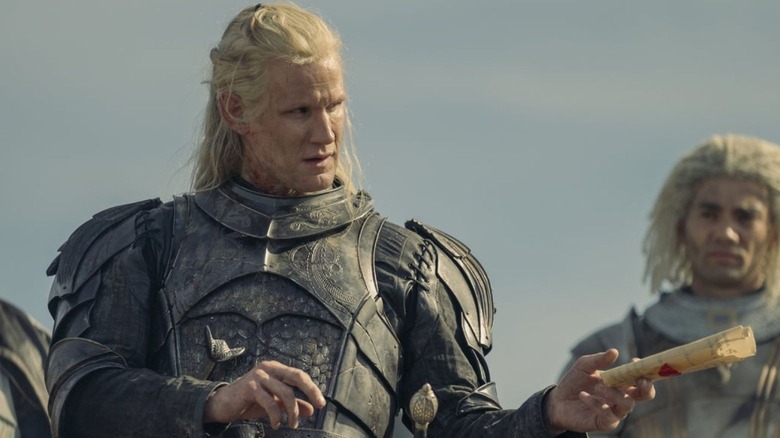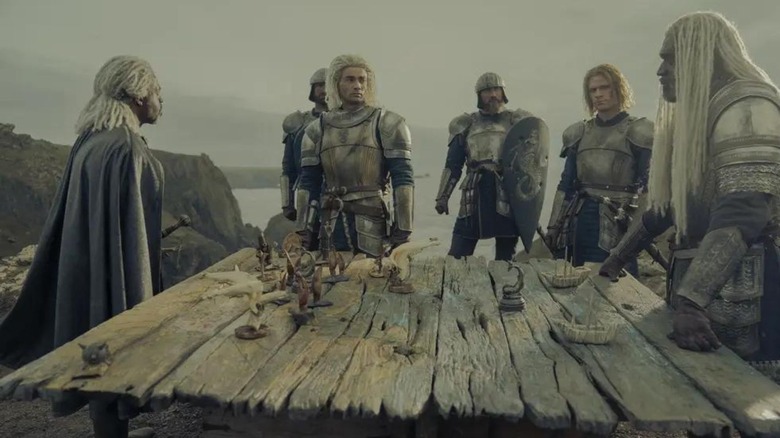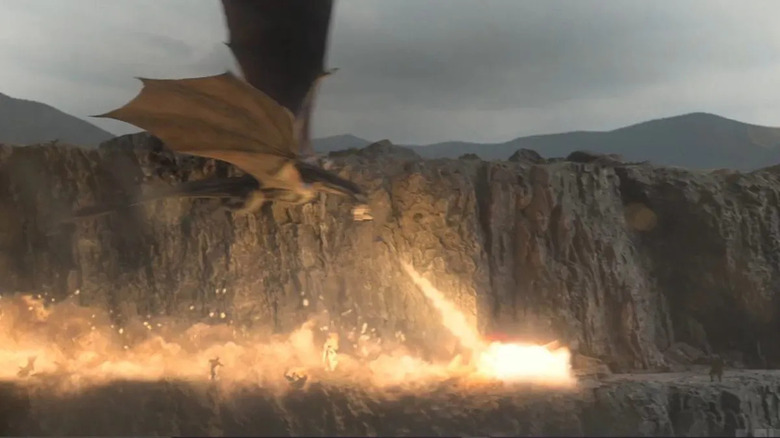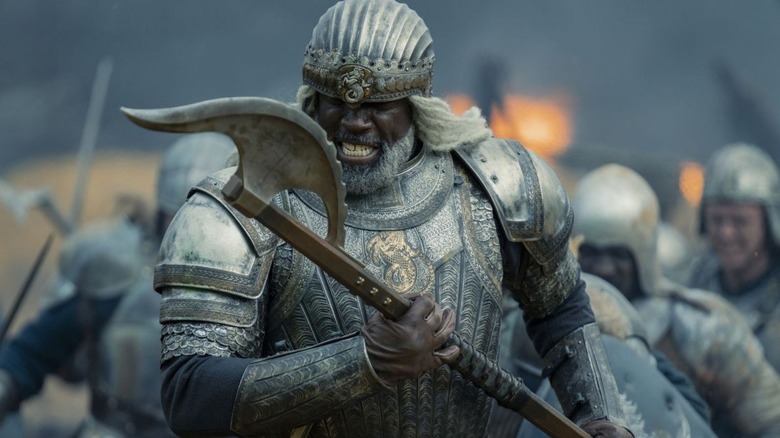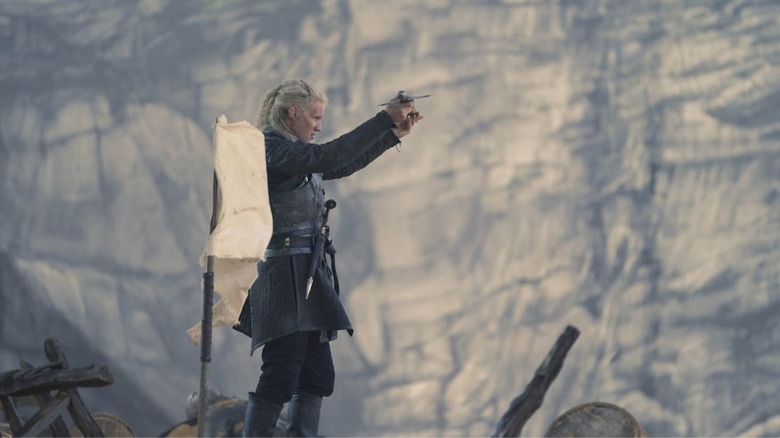House Of The Dragon's First Major Battle Scene Is Fantasy Warfare Done Right
This article contains spoilers for the third episode of "House of the Dragon."
Fantasy is the most imaginative genre there is. The ability to conjure and craft entire worlds with characters that call them home always makes for a larger-than-life setting. It also makes for great television. Fantasy novels and television shows have paved the way for epic otherworldly battles and wondrous warfare sequences that are exciting to read and witness. Whether it's the Battle of the Pelennor Fields from the pages of J.R.R. Tolkien's "Lord of the Rings" universe or the many battles of "Game of Thrones," the scope of fantasy warfare is only increasing, as evidenced in "Second of His Name," the third episode of "House of the Dragon."
When comparing "House of the Dragon" with its predecessor, you'll see that a lot has changed: the show progresses at breakneck speed, refusing to waste your time. It's unmistakably better-looking in terms of its visuals and cinematography, and it immediately introduces you to its mystical fire-breathing beasts. And with three episodes released, it has already proved that a good battle doesn't need to span an entire episode. "Game of Thrones" has given us some of the most compelling action sequences on television, from combats to huge showdowns, but "House of the Dragon" presents us with a bloody, brutal and distinctive battle scene (which lasts only 12-odd minutes) in only its third episode, and it's fantasy warfare done right.
Swords, axes, and a dragon
The newest episode of "House of the Dragon" features the pettiest man in all of Westeros — Prince Daemon Targaryen (Matt Smith) and the Sea Snake Corlys Velaryon (Steve Toussaint) staging a crown-unsanctioned war in the distant Stepstones, three years into an alliance they formed after being wronged by King Viserys (Paddy Considine). The two have been battling against the Crabfeeder (Daniel Scott-Smith) and his troops for a long time, to little success. The army of the Crabfeeder, aka Craghas Drahar, finds shelter in the caves, making it impossible for his enemies to launch a successful offensive and take control of the Stepstones.
That is, of course, until Daemon Targaryen takes matters into his own hands. After receiving a letter from his brother that reveals help is coming, Daemon feels insulted about his failures and launches a one-person suicide mission. He travels into enemy territory alone, pretends to surrender his Valyrian steel-forged sword, and kneels ... before changing his mind, which was his plan all along. Daemon single-handedly holds his own against the Crabfeeder's soldiers until Corlys charges with his forces. Despite its short runtime, the ensuing battle is easily one of the most thrilling battle sequences in the franchise's history. Unlike the most famous battles of "Game of Thrones," this one doesn't need an hour to imprint itself in your memory.
The War for the Stepstones has what many before it didn't
"Game of Thrones" took its due time to set up its major battles during its many seasons. While most wars were fought on horseback, behind shields, and with the aid of swords, the first battle in "House of the Dragon" has what its predecessor did not: It is backed by a dragon. We see hundreds of soldiers charging against each other, Daemon Targaryen evading hundreds of arrows (like a pro, may I add) at once, and close-up shots featuring brutal kills. And then, for a moment, Daemon appears genuinely helpless. His weapon-wielding adversaries surround him, and then Laenor Velaryon (Theo Nate) appears out of thin air, seated on his dragon Seasmoke, Dracarys-ing the hell out of the Crabfeeder's army.
Watching a dragon soar over a battlefield was always an anticipated moment in "Game of Thrones," but in "House of the Dragon," it's no surprise. The Valyrians were dragon lords. Obviously, they're going to use the one impenetrable weapon they own. It's hard to win a war when you don't have an army. But even a single fire-breathing dragon can turn the tide during a war, as it does during the episode, rendering Daemon and Corlys victorious in their efforts to capture the Stepstones.
The scale of action is astonishing
After Laenor desecrates the Crabfeeder's army, an injured Daemon charges into the Crabfeeder's cave and emerges with the upper half of his body. The Rogue Prince has a penchant for dismemberment and violence, and this scene proves how far he's willing to go.
To add to its poetic effect, Daemon doesn't utter a single word from the moment he steps down from his dragon. He is then belittled by his allies and insulted by his brother, and reacts to it by sailing through the waters alone and giving himself up as bait ... even if temporarily. Matt Smith's spectacular portrayal of the Rogue Prince and the character's courageous, impulsive nature is a big part of what makes the action all the more exciting.
The battle is reminiscent of Game of Thrones, but better
Many moments in the battle feel like a callback to "Game of Thrones." Daemon finding himself alone is a reminder of Jon Snow during the Battle of Bastards, and Daemon evading the hundreds of arrows meant to kill him is a reminder of what Rickon Stark could not accomplish. The inclusion of a dragon, Daemon giving himself up as if he were a madman, and the sheer power displayed by the Valyrian houses are what sets the scene apart from the rest.
The importance given to the War for the Stepstones in this episode is a great way to represent the significance of dragons on the battlefield. It also displays how strong "House of the Dragon" already is, three episodes in. Its singular attempt at depicting open warfare is not only neat storytelling but also one of the most thrilling depictions of war we have seen in a while. There's something exciting about feeling like all is lost — right before all is saved. And "House of the Dragon" does nails that idea effortlessly.
The episode uses its culminating moments to reinforce Daemon's impulsive valor — and his ability to do pretty much anything out of spite. It also demonstrates how great of a warrior he is, and the foresight he possesses. And how with or without a dragon, he can always be trusted to lead a fight. I'm waiting for more with bated breath.
